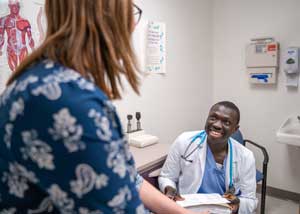Rural North Dakota Facilities Persevere with Non-physician Workforce
By Stacy Kusler on
Nurse practitioners (NPs) and physician assistants (PAs), or non-physician healthcare workforce, have played an integral role in American healthcare for decades (since 1965 and 1971, respectively). And because primary care physicians can be hard to recruit and retain in rural areas, some North Dakota hospitals rely on these non-physician or "allied" health providers more than ever.
The Challenge with Physician Recruitment
Just ask Beverly Vilhauer, CEO of South Central Health in Wishek, North Dakota. Her rural community has been without a physician since December 2018. As a result, daily patient care in the hospital, emergency room, two nursing homes, and four rural health clinics in neighboring rural towns is the responsibility of a patient care team made up of four NPs and two PAs, with a contracted physician to serve as a medical director from more than 90 miles away.
It's a daunting task, to be sure. Though South Central Health's search for a physician has not necessarily ended, patient needs are being met with its small but mighty team.

"We are grateful for NPs and PAs," Vilhauer said. "They are somewhat easier to recruit to rural areas, and we try to keep them engaged by encouraging and supporting them to pursue their passions in the patient care setting."
Wishek had two physicians on staff at one point, but retention proved difficult because the physicians and their families were drawn to larger communities. Physicians' spousal satisfaction and the ability for spouses to find work are often noted as factors in the ability, or inability, to retain a physician workforce. Despite its best efforts to accommodate the needs of the physicians and their families, Wishek, like many rural communities, struggles to compete with larger communities. It has adjusted accordingly, and the community is supportive, even though a physician is not on staff full time.
I have had patients stop by my office and provide positive feedback after having been seen by our providers.
"I have had patients stop by my office and provide positive feedback after having been seen by our providers," Vilhauer said. "I even had a patient ask what we are doing to keep an NP, as he really liked the care that he received."
Flexibility Is Key
In another part of the state, similar adjustments to patient care teams have occurred. Jody Nelson is the CEO of St. Luke's Medical Center in Crosby, North Dakota. Since 2016, her facility has been operating on a mostly NP and PA model, with two physicians on-site a few days a month. Crosby employs six providers. Just one of them lives in the community of Crosby. The other providers either fly or drive in on a rotating basis. While there are challenges with this model (namely finding temporary housing for the traveling providers or navigating weather events that may cause travel delays), Nelson says this is a model that works for them, and they plan to continue it while they can.
We were struggling to find providers and their families that wanted to move to and live in our rural community.
"We were struggling to find providers and their families that wanted to move to and live in our rural community," Nelson said.
But now, with a model that allows providers and their families to continue living where they are, St. Luke's Medical Center has more providers for patients to choose from, which is a big advantage for its small town.

"Since we are a small rural hospital, having six different providers to pick from is very unique. We feel we have a provider for everyone at St. Luke's," Nelson said.
But the community had to adjust to this new model. "At first our patients did not like the idea of some providers not making Crosby their home, but that has quickly been replaced with acceptance," Nelson said. "The key has been consistency of our traveling providers and educating our patients that our providers are part of our team at St. Luke's, even though they don't live in our community full time."
New Law Removes Barriers for PAs
NPs in North Dakota have independent practice authority, which means they do not need physician oversight or a collaborative agreement to provide care to patients. North Dakota House Bill (HB) 1175, which passed unanimously in April 2019, now allows PAs the same authority, making North Dakota one of the first states to remove this barrier.
Jay Metzger, PA-C, is the current board president for the North Dakota Academy of Physician Assistants. He is also an assistant professor of physician assistant studies at the University of North Dakota School of Medicine & Health Sciences.
Metzger helped draft the bill that was eventually passed into law. He explained that this new legislation does not mean any PA can practice without oversight, but it does allow an easier path for facilities to fill their open positions.
"Even though the enactment of this legislation doesn't require PAs to have a state-mandated supervisory agreement with a physician, we still must practice within the scope of our education and training," Metzger said.
This change is certainly an advantage to rural communities, such as Wishek and Crosby, which may not have a supervising physician on-site all the time.
"Physicians are becoming more reluctant to take responsibility for PAs. Therefore, many institutions did not even consider qualified PAs to fill their open practice positions [before HB 1175]," Metzger said.
Metzger hopes this new law helps rural and underserved communities hire qualified PAs, closing the gaps in patient care due to physician workforce shortages.


 is the connection between rural healthcare facilities in North Dakota and qualified health professional job seekers. As the workforce specialist, she assists rural facilities to attract medical providers and other health professionals to their communities by sharing job opportunities. Through her position, Stacy is working to reduce the healthcare workforce shortages throughout the state.
is the connection between rural healthcare facilities in North Dakota and qualified health professional job seekers. As the workforce specialist, she assists rural facilities to attract medical providers and other health professionals to their communities by sharing job opportunities. Through her position, Stacy is working to reduce the healthcare workforce shortages throughout the state.



